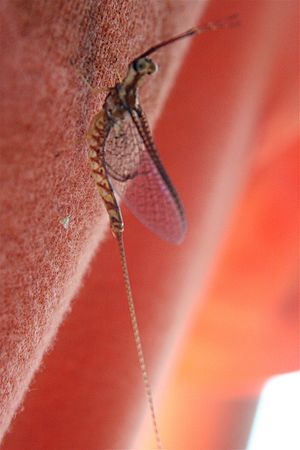Giant mayfly facts for kids
Quick facts for kids Hexagenia limbata |
|
|---|---|
 |
|
| Scientific classification | |
| Kingdom: | |
| Phylum: | |
| Class: | |
| Order: | |
| Family: |
Ephemeridae
|
| Genus: |
Hexagenia
|
| Species: |
H. limbata
|
| Binomial name | |
| Hexagenia limbata (Serville, 1829)
|
|
The giant mayfly, also known as Hexagenia limbata, is a type of mayfly. You can find them all over North America, especially near lakes and slow-moving rivers. Their young, called nymphs, live underwater and dig tunnels in the mud. Adult mayflies only live for a very short time. Around the Great Lakes, people sometimes call them "fish flies." This is because when many of them emerge, the air near the water can smell a bit like rotten fish.
Contents
What Does the Giant Mayfly Look Like?
Adult giant mayflies can grow up to 27 millimeters (about 1 inch) long. Female mayflies are usually a bit bigger than the males. However, the females have smaller eyes.
These insects have two pairs of wings. Their front wings are long and thin. The back wings are much smaller and have dark edges. At the end of their body, they have two long tails, called cerci. When a mayfly rests, its wings fold straight up over its back. Giant mayflies can be different colors. They are often yellow, light brown, or white.
Where Do Giant Mayflies Live?
The giant mayfly is the most common type of mayfly in North America. You can find them in most parts of Canada. They also live in almost all states in the United States, except Alaska and Arizona. They are most common around the Great Lakes region.
Giant mayflies like to live in lakes and slow-moving rivers. These places must have muddy bottoms. This is where their young, the nymphs, can dig their homes. Adult mayflies gather in large groups near the water. They also rest on plants nearby.
The Giant Mayfly Life Cycle
The life of a giant mayfly starts when the female lays her eggs in the water. These tiny eggs sink to the bottom. Some eggs hatch quickly. But many eggs stay on the bottom all winter. They hatch when spring arrives.
From Egg to Nymph
When a nymph first hatches, it is only about 1 millimeter long. It has a long, tube-shaped body. As it grows, it sheds its skin up to 30 times! Nymphs have special tusks on their mouths. They use these tusks to dig. They also have three pairs of legs. As they get older, small wing pads start to grow on their backs. They also have three long tails.
Nymphs dig U-shaped tunnels in the mud. They live inside these tunnels. They have seven pairs of feathery gills on their bodies. These gills help them breathe underwater. They also use their gills to move water through their tunnels. This brings in fresh air and food. In cold northern lakes, it can take two years for a nymph to grow fully. But in warmer southern canals, they might grow in as little as 17 weeks.
Becoming an Adult Mayfly
When a nymph is fully grown, it swims to the water's surface. It then changes into a new form called a subimago. This stage looks a lot like an adult mayfly. But its wings are cloudy, not clear. Also, it cannot reproduce yet.
After one to three days, the subimago flies to a resting spot. There, it sheds its skin one last time. Then, it becomes a fully grown adult, called an imago. Now, it can reproduce.
What Do They Eat and Who Eats Them?
Adult mayflies and subimagos do not eat at all! They do not even have working mouths. Mayfly nymphs are mainly detritivores. This means they eat tiny bits of dead plants and animals. They use their gills to pull these food particles into their burrows.
Many animals like to eat mayflies. Nymphs are hunted by dragonfly nymphs. These predators can attack them right in their mud tunnels. Mayfly nymphs usually stay in their tunnels until they are ready to become adults. When they swim to the surface, their skin splits open. They then fly off as subimagos. At this time, they are easy prey. Fish, dragonflies, and birds all eat them.
The "Hatch"
Fishermen call the emergence of mayflies the "hatch." This can be a huge event! Millions of mayflies can emerge at the same time. Scientists think this helps them find mates more easily.
Mayflies are attracted to human lights at night. This can cause huge swarms around gas stations or streetlights. Sometimes, car lights attract so many mayflies on bridges that the road becomes slippery. In some cases, the massive "hatch" of mayflies can even show up on weather radar! While not all mayflies emerge at the exact same moment, there is usually a very strong peak time for the hatch.


